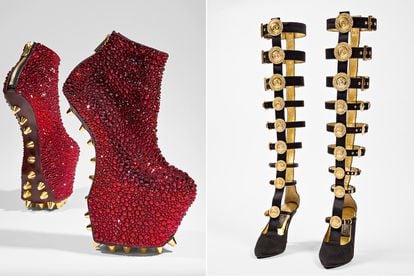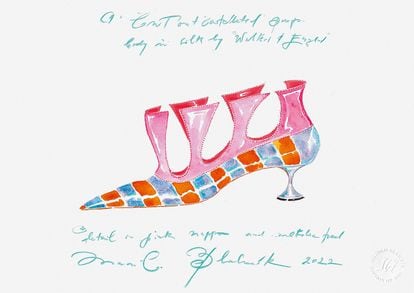I'm a silver Jimmy Choo sneaker person. A few years ago The New York Times did an article about me in which they called me 'the historian of heels', but I almost never wear them anymore, I wear more sneakers, ankle boots, ballet flats or loafers,” says Valerie Steele (Boston, 68 years old) from her office. The director of the museum Fashion Institute of Technology (FIT) from New York – which he joined in 1997 – crouches down until he disappears from the video call screen to confirm by looking under his table what shoes he is wearing. Yes, they are designer sneakers. “With them I can kick the whole city, but at the same time they are cool and glamorous,” he explains. He assures that “sneakers, which have been around for more than 100 years, have really revolutionized the world of footwear in the last 20 years, especially women's fashion.” He knows it well: Steele, who year after year appears on the list of the 500 most influential people in the world of fashion drawn up by Business of Fashion, He has dedicated his life to studying clothing, curated more than 25 exhibitions, published books on the history of fashion and now selects about 400 pairs from the FIT collection (which totals around 5,000) to explain what we can know about the world to through them in Shoes AZ (Taschen).
Holds the heiress, fashion guru and zapatophila Daphne Guinness recognized in the book's prologue that “a shoe says more than a thousand words about the person who wears it.” For her, “shoes are much more than practical accessories that protect us from the ground we walk on.” They are, many times, “a status symbol.” Steele agrees with her friend. “From what we know about Neolithic clothing and footwear, shoes are one of the first garments that emerged to protect the body. Its creation probably developed before most forms of clothing, weaving and sewing, skin or bark was tied around the feet to protect them from the cold and rocks. Then they began to symbolize all kinds of things, such as status, gender or sexuality. They could also be defensive, we see it with the soldiers of the Roman Empire: their boots served to protect, but you could also break someone's bone if you hit them in the shin with them,” she summarizes.

That desire to know what clothing has meant throughout the centuries was what pushed Steele to immerse herself in something that in academia was not seen as a serious field of specialization when she was studying at Yale. There, a colleague of hers discovered an article from the feminist publication Signs about the meaning of the corset in the Victorian era. In this way, Steele realized that talking about fashion was not something frivolous, that it was necessary to delve deeper into the impact of clothing throughout history. “Although there are more and more young people who want to be fashion historians, curators or critics, it is still not something that has been completely accepted in the academic world. There are more studies in marketing, design or fashion merchandising,” she points out.
Within the extensive discipline of fashion history, footwear is just another section, but after curating various exhibitions Steele has come to the conclusion that this area is especially attractive: “Shoe exhibitions are incredibly popular with the public.” . Shoes speak about who wears them: they can tell if you are a man or a woman, rich or poor, modern or conservative. “People believe that the right pair of shoes can change their life.”

What the feet reveal
But why are shoes so fascinating? Steele remembers that in 1995 the average American had 12 pairs of shoes and estimates that today that number will be around 30, as in her case. “Now I tend to have fewer and
wear them more often, but a lot of my friends have 100 pairs,” she says. He has observed that part of the enjoyment of footwear comes from the experience of purchasing it: “For many people, buying shoes is pure pleasure, unlike swimsuits.” He also believes that “shoes attract because they have a silhouette, they do not depend on the shape of the body, like most clothes, which when you take them off happens like a snake sheds its skin. The shoes stay there like a little sculpture.”

Among the most notable in the FIT collection, he mentions the Flame by Prada, the Fetish Ballerina by Christian Louboutin or the stiletto of zebra by Manolo Blahnik. Which one do you dream of adding to the list? “Alexander McQueen's Armadillos, which were created just for the parade. At the last auction they were sold to the Met for $60,000, a figure we couldn't afford. But we have two pairs of original Air Jordans, which are among the most famous pieces in history,” notes Steele. Although in the book she talks about designers who have marked an era—from Capezio to Jimmy Choo to Charles Jourdan—she also analyzes with curator Colleen Hill the evolution of footwear throughout history. “The development of designer shoes is very late, most are from the 20th and 21st centuries, before there were only shoemakers.” Continuing with the details that have shaped the collective imagination, she emphasizes that “the first to wear heels were men in the 17th century, they looked taller and strutted. They came from Persia to France through the Persian ambassador and Louis XIV and all the French aristocrats immediately saw the advantages of being taller. Women soon copied him, but their heels were narrower, which made their way of walking more unstable.”

The study of footwear also reveals details related to physiognomy, sexuality or obsessions. In fact, for 2025 Steele is preparing an exhibition on fashion and psychoanalysis in which shoes will play a fundamental role. “We will talk about phallic symbols, the eroticism of shoes, fetishes,” she advances. And the identification of footwear with eroticism comes from afar: “Already in 1700 there was a fetishization of heels for women, and before that the prostitutes of the Roman Empire wore sandals, or the Venetian chopines of the Renaissance, with their enormous platforms, were associated with eroticism and sometimes with prostitution, although they were also worn by respectable women… So the sexualization of women's shoes begins early and is caused by more than one thing. It may even come from brain connections, because studies say that the part that corresponds to the genitals is right next to the part that corresponds to the feet and it is possible that there are cross connections that make you feel more inclined to think that the feet and what they are covers are more erotic than other parts of the body.”
And what does the rise of sneakers or the popularity of so-called 'ugly shoes' like Birkestocks say about today's society? “Sneakers are today a way to dignify a kind of youth and sporty air. They can cost as much as leather shoes, they are no longer just a matter of comfort or informality, but a statement about the type of person you are. And Birkenstocks are an interesting phenomenon, what was once considered an 'ugly shoe' has suddenly become cool. “I think it shows that our gaze has readjusted, that there are more daring ways to be attractive.”
#wear #heels #men #17th #century #true #origins #accessory #status #symbol